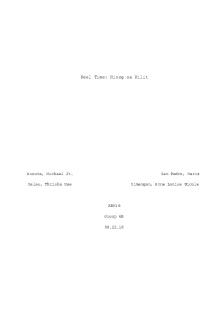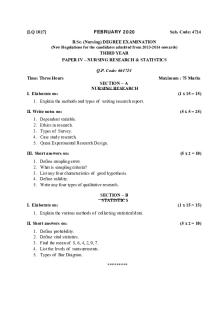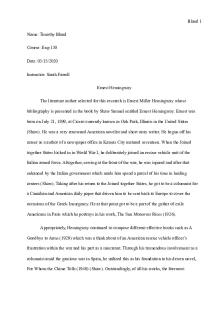research title about psychologyfirst year PDF

| Title | research title about psychologyfirst year |
|---|---|
| Course | Psychology |
| Institution | Our Lady of Fatima University |
| Pages | 8 |
| File Size | 419.3 KB |
| File Type | |
| Total Downloads | 432 |
| Total Views | 921 |
Summary
Download research title about psychologyfirst year PDF
Description
ISSN: 2638-1605
Madridge Journal of Nursing Research Article
Open Access
The Impact of Duration of Sleep on Academic Performance in University Students Heather Raley, Jessica Naber*, Summer Cross, and Michael Perlow Department of Nursing, School of Nursing and Health Professions, Murray State University, Murray, USA
Article Info
Keywords: Sleep; Immune system functioning; Mood; Academic performance.
*Corresponding author: Jessica Naber Assistant Professor Department of Nursing School of Nursing and Health Professions Murray State University Murray, USA Tel. 502-541-3011 E-mail: [email protected]
Introduction
Received: May 31, 2016 Accepted: June 28, 2016 Published: July 4, 2016 Citation: Raley HR, Naber JL, Cross S, Perlow MB. The Impact of Duration of Sleep on Academic Performance in University Students. Madridge J Nurs. 2016; 1(1): 11-18. doi: 10.18689/mjn-1000103 Copyright: © 2016 The Author(s). This work is licensed under a Creative Commons Attribution 4.0 International License, which permits unrestricted use, distribution, and reproduction in any medium, provided the original work is properly cited. Published by Madridge Publishers
University students report significantly worse quality of sleep, including inconsistent sleep schedules and sleep deprivation, than the general population. They also suffer from a greater amount of daytime sleepiness than the general population. Students also report significantly fewer total hours of sleep each night than the daily-recommended amount, for their age group, to promote normal cognitive functioning. Students tend to sacrifice sleep to participate in social and academic commitments contributing to constantly changing sleep routines and poor sleeping habits. All of these factors may affect aspects of the average university student’s life including mood, immune system function, and even substance abuse (Orzech, Salafsky, & Hamilton, 2011). The focus of this study was to assess the student’s ability to perform academically in relation to his or her quality of sleep. Despite the fact that a vast amount of time in adolescence is spent learning and improving education, there is a large gap in research examining the relationship of sleep and academic functioning and performance (Shochat et al., 2014).There is a lack of knowledge of very simple modifications in sleep hygiene to improve the quality of sleep in university students, and subsequently, their overall academic performance. The purpose of this study was to answer the following research question: Does duration of sleep affect univerity students’ overall academic performance?A questionnaire was developed to determine sleep habits, subjective perceptions of one’s own sleep quality, and any factors that affect the management of sleep and academic performance in university students. The hypothesis was that students who have a longer duration of sleep will have a better academic performance demonstrated by a higher grade point average (GPA)The researcher proposed to investigate the need for implementing a sleep education program component to improve the overall quality of sleep in university students.
Review of Literature
Madridge J Nurs. ISSN: 2638-1605
Shochat et al. (2014) propose that despite the fact that a vast amount of time in adolescence is spent learning and improving education, there is a large gap in research examining the relationship of sleep to academic functioning and performance. Brown et al. (2006), Chen et al.(2014), and Hershner and Chervin (2014) suggest that there is a connection between quality of sleep and students’ academic performance. Giannotti et al. (2002) propose health concerns that can present in sleep-deprived students, which include depression, fatigue, and difficulties with attention, concentration, decisionmaking, learning, and facilitating memories. Orzech et al. (2011) discuss how daytime sleepiness results in decreased attention and concentration, which negatively impacts Volume 1 • Issue 1 • 1000103 11
Madridge Journal of Nursing learning and memory recall in students. Chen et al. (2014) states that many different variables in the students’ sleep environment, such as intrusive light or noise, may have an effect on their quality of sleep. The sleep duration the student is able to obtain determines the amount of rapid eye movement (REM)sleep cycles, memory consolidation and learning the student receives (Hershner & Chervin, 2014). Milner and Cote (2008) and Gomes et al. (2011) discuss how sleep schedule irregularity and napping can affect student’s quality of sleep by delaying the body’s natural circadian rhythm and homeostatic sleep drive. Finally, Brown et al. (2006) discuss how reversing the lack of knowledge regarding behaviors and lifestyle choices that hinder or promote sleep is promising because the distribution of the information can improve students sleeping habits. Hershner and Chervin (2014) and Brown et al. (2006) agree that a sleep education program should be implemented to improve sleeping habits and hygiene of students.
Methods Sample The study was conducted at a midsize, rural, public university in the southern United States between the dates of 10 February and 10 March 2015. Institutional Review Board (IRB) approval was obtained, and the study included a systematic convenience sample of students from all student classification levels (undergraduate freshman, sophomore, junior, senior; and graduate) of the student population currently enrolled in university courses. Inclusion criteria included the following: (i) age over 18 years; (ii) student currently enrolled in courses at the university. Instrument The questionnaire (see appendix) was produced reflecting background data from research reported in the review of literature. A panel of doctorally prepared nurse faculty evaluated the instrument used for data collection and provided content validity to the questionnaire. Each participant was asked to complete a self-administered online survey that included the collection of demographic information such as gender, age, and ethnicity. The questionnaire included 19 questions consisting of a sleep profile and an academic profile, assessing quality of sleep and academics. The sleep quality profile encompassed sleep duration, sleep environment variables, daytime sleepiness, and the use of sleep remedies. The academic profile encompassed the number of enrolled courses, and the current cumulative grade point average (GPA) which was broken down in to four categories: GPA of 3.50 or higher (Mostly As), GPA of 3.00 to 3.49 (Mostly Bs), GPA of 2.50 to 2.99 (Some Bs and Cs), GPA of 2.00 to 2.49 (Mostly Cs). The questionnaire also included a question as to whether the participants believed they were receiving an adequate amount of sleep each night and if they believed they were suffering from a sleep disorder. The responses to these questions were organized categorically into the options of “yes” or “no.” [1-5]. Madridge J Nurs. ISSN: 2638-1605
Question 6, which read, “When do your classes normally begin each day?” was omitted from the data analysis because 55.7% of respondents did not respond in part, or skipped this question altogether. Since the students had to indicate on one drop down menu when their classes began for multiple days of the week, the participants may have found it difficult to answer this question. Procedures The recipients of the email (residential college directors) were asked to electronically distribute the online selfadministered questionnaire to their constituents. The constituents included the following: honors program students, students taking introductory psychology courses, and students affiliated with residential colleges. The data collection was conducted electronically for convenience, allowing students of all classifications, majors, and type of residence to complete the questionnaire. The students were invited to complete the survey on their own time before the deadline to close the questionnaire on 10 March 2015. The potential participants were provided with a cover letter explaining the purpose of the questionnaire, inclusion criteria, that information collected would remain anonymous, that participation was voluntary, and that there was no penalty for withdrawal of participation in the study. The participant’s completion and return of the questionnaire indicated voluntary consent to participate in this research study, as mentioned in the cover letter. Statistical Analysis Data were entered and analyzed using a computer program, R commander (Rcmdr), which is a platformindependent basic-statistics GUI (graphical user interface) for R programming language (Fox, 2005). This program was used to analyze the sample demographics and answers to the questionnaire. Tests for group trends used χ² test for independence to compare categorical data results from two separate questions. A one-way analysis of variance (ANOVA) was used to test for significance in difference of means for normally distributed numerical data of independent groups. To dichotomize the scores, the groups of participants taking less than or equal to three courses were consolidated, because it contained less than 5% of the total sample. Statistical significance was denoted by P values...
Similar Free PDFs

Research about cyberbullying
- 31 Pages

research about Online services
- 16 Pages

Research about Multipurpose Hall
- 12 Pages

EAcademic year Academic year
- 2 Pages
Popular Institutions
- Tinajero National High School - Annex
- Politeknik Caltex Riau
- Yokohama City University
- SGT University
- University of Al-Qadisiyah
- Divine Word College of Vigan
- Techniek College Rotterdam
- Universidade de Santiago
- Universiti Teknologi MARA Cawangan Johor Kampus Pasir Gudang
- Poltekkes Kemenkes Yogyakarta
- Baguio City National High School
- Colegio san marcos
- preparatoria uno
- Centro de Bachillerato Tecnológico Industrial y de Servicios No. 107
- Dalian Maritime University
- Quang Trung Secondary School
- Colegio Tecnológico en Informática
- Corporación Regional de Educación Superior
- Grupo CEDVA
- Dar Al Uloom University
- Centro de Estudios Preuniversitarios de la Universidad Nacional de Ingeniería
- 上智大学
- Aakash International School, Nuna Majara
- San Felipe Neri Catholic School
- Kang Chiao International School - New Taipei City
- Misamis Occidental National High School
- Institución Educativa Escuela Normal Juan Ladrilleros
- Kolehiyo ng Pantukan
- Batanes State College
- Instituto Continental
- Sekolah Menengah Kejuruan Kesehatan Kaltara (Tarakan)
- Colegio de La Inmaculada Concepcion - Cebu











